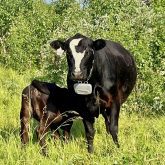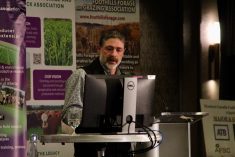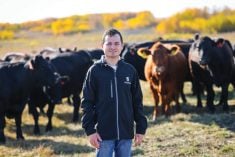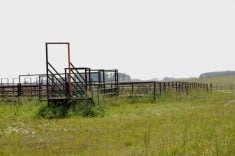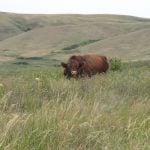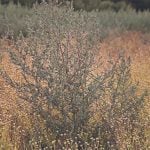Anyone farming and ranching in the Great Plains is going to have to deal with drought, so it’s best to be as prepared as possible.
That was the message from Anneliese Walker at the Canadian Forage and Grasslands Association conference last fall. Walker is a Princeton, Minnesota producer who also works for Maia Grazing, which offers grazing management software.
Living in the rain shadow of the Rockies means a lot of rainfall variability, says Walker. “Anywhere that is in the Western Plains is going to typically be in drought up to 30 per cent of the time.”
Read Also
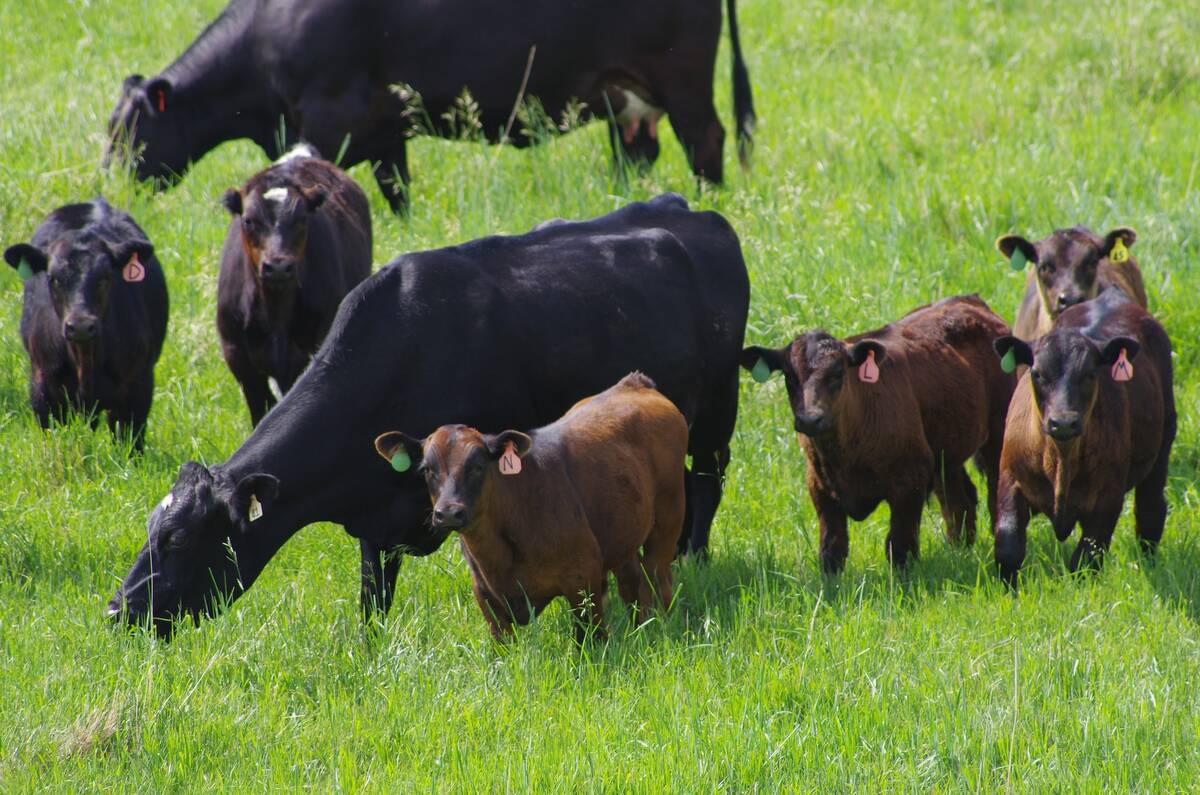
Diagnosing and preventing lump jaw in beef cattle
Causes, symptoms, treatment, prevention and prognosis of lump jaw in beef cattle
Walker’s preferred definition of drought is a period with below normal precipitation during which soil water content is reduced enough that plants suffer from a lack of water. Typically, if you’re 25 per cent below the median rainfall you’re at, or heading towards, drought, she adds.
Timing is everything for forage, as spring rains spur pasture and hay growth much more than rain after July.
“If April is dry, you really only have a 40 per cent chance of making your median precipitation by the end of spring. So, again, if your April is dry, if you don’t get your long-term median rainfall for the year-to-date by the end of May, it’s very likely you’ll be in drought for the balance of the season.”
No matter the landscape producers are working with, they will share some common ground when they experience drought. For example, more pest pressure, decreases in forage availability and quality, more lower-succession species such as woody brush or invasive plants, and a reduction of animal performance are all issues Walker hears from clients.
Producers can also expect economic fallouts such as increased feed prices until the seasons following the drought’s break, plus market fluctuations. After all, if you’re heading into drought, so is your neighbour.
“It’s just a matter of how are you going to differentiate yourself and how are you going to create that decision-making process for your operation.”
Producers have a few options to manage and respond to impending drought. A common lever to match feed demand to forage supply is de-stocking. But that often means large numbers of animals headed to slaughter at the same time, which means deflated prices.
Timing is everything when it comes to de-stocking. Producers can do it before the drought hits or during drought. Delaying until there’s no feed is going to have a “heavy, heavy impact on your changes in net return,” says Walker.
During drought, direct costs will increase “pretty significantly simply because substitution feeding is so much more expensive than grazing is. And so making sure that you’re making money off every single pound of beef that you sell off your place is going to be pretty critical, especially during drought years when your margins are going to be so thin.”
Drought resilience
Preparing for drought looks a little different than de-stocking the cow herd during drought.
One option is to reserve forage supply by stocking conservatively, increasing rest periods and banking grass. In an average or wet year, producers leave excess forage for drought years.
Another idea is to vary your stocking rate, says Walker. “So, if you are primarily a cow-calf operation and you know that you can cash-flow the cow-calf operation on better years, as you get a surplus of rain and therefore a surplus of forage, then you can take on some custom-grazed cattle for a little bit of additional cash flow. Absolutely something to look at.”
Producers can also incorporate yearlings that they can “easily shed” when drought looms. The key is to keep an eye on the weather and de-stock “before everybody and their cousin does,” says Walker.
Whether producers stock conservatively or adopt a flexible stocking policy, they’re approaching the same problems in different ways. “Do I bank feed, or do I leverage everything I have every year?”
Those following a flexible stocking policy will be asking themselves which cattle to remove or add, depending on the year. Walker suggests creating a stocking and de-stocking policy and sticking to it. Following it is the important thing, she adds. “Underline it, bold it. It is the hardest thing to do because you just want to hold onto these things. But in the long run, it can really make your ranch more resilient.”
Banking forage begs a different question. “On the flip side, the conservative stocking policy is going to say, ‘Where do I stockpile?’”
Before creating a stocking policy, Walker recommends determining gross margins by enterprise, to figure out overall financial health of the ranch and which classes of cattle to shed. Gross margin = (total revenue – cost of goods sold)/total revenue.
Next, collect historical data, such as grazing charts, stocking rates, rainfall records and production records.
Then, producers can create a working knowledge of current feed position. “If you don’t know how much you have in the bank, how will you create a budget?”
Finally, calculate carrying capacity. Producers can ask themselves how many animals they can carry in an average year and what that looks like on their landscape.
Producers can then compare their long-term stocking rates to different rainfall scenarios by forecasting their stocking rates to carrying capacity. Doing so eliminates guessing games, identifies drought potential, allows them to de-stock before markets flood, identifies potential income streams during drought and avoid a panic-induced management strategy. Walker typically starts forecasting with an Excel spreadsheet, running scenarios such as 10 per cent below median rainfall, and adding animals to see what she’ll be carrying in a given time. She then uses Maia Grazing’s forecast, matching stocking rate to carrying capacity.
Whatever the program, Walker sees a few things vital to any stocking policy:
- Critical rainfall dates. Identify the plant species in the pasture, ecological growth curve and average monthly rainfall values.
- Critical de-stocking dates.
- Forecast of stocking rate to carrying capacity. The forecast can contain both critical de-stocking dates and critical rainfall dates. De-stock animals/enterprises that don’t have the greatest profit margin.
- A grazing plan, including what the pasture has produced in the past. If producers don’t have enough feed by the critical dates, they can start pulling animals or making marketing decisions.
Walkers says she is a huge proponent of data-driven grazing. “It is an art and it is a science.”
Dr. Fernando Maestre Gil, a researcher at the University of Alicante in Spain, was the lead writer of an article published in 2022 in Science magazine called “Grazing and Ecosystem Service Delivery in Global Drylands.”
A large global survey was conducted across 25 countries on six continents and surveyed 326 dryland sites.
In an email interview, Maestre Gil says there’s a lack of global research on grazing’s effects on dryland ecosystems, despite the importance of grazing. Researchers were motivated by the importance of maintaining these ecosystems, he says.
Maestre Gil explains that they worked with a team of collaborators across the globe and followed a standardized field protocol. According to the paper, fieldwork is carried out using standard tools, such as a soil corer and a hammer. This made it easy for many researchers from across the world to participate. It also minimized costs, allow researchers from underrepresented areas to join, such as Africa and Latin America.
Plots were 45 metres by 45 metres and were selected on a “grazing pressure gradient” — including ungrazed, low, medium and high grazing pressure. There was one Canadian site in B.C., and various others in North America.
Researchers determined that climate greatly affects the soil’s productivity.
“Interactions between grazing and climate were especially important; warmer sites had lower rates of carbon storage, organic matter deposition, and erosion control under high, but not low, grazing pressure,” Maestre Gil says.
The study found grazing had positive effects in colder climates and species-rich areas. For producers who live in colder climates, such as Canada, Maestre Gil says the study results can be used to bolster pasture productivity.
“Our results can be used to minimize the environmental impact of grazing and to maximize their benefits for ecosystems and people,” he says.
For example, increased plant diversity in grazing areas can yield multiple environmental benefits, he says. Introducing additional livestock species, without increasing grazing pressure, is also beneficial, he adds. But producers in warmer climates should be aware that their ecosystems are very fragile and increasing livestock pressure can degrade rangelands, he adds.





